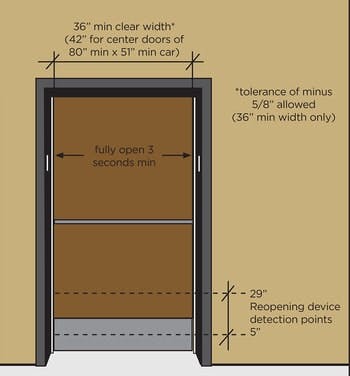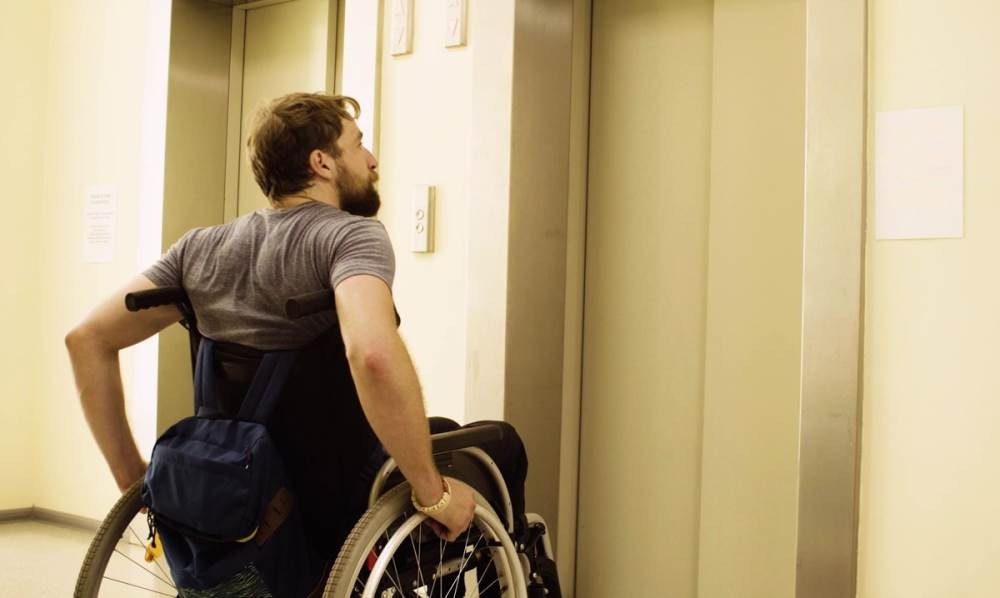Avoid liability by reviewing the ADA requirements for elevators in both new and existing buildings, and read about possible instances in which your elevator could be non-compliant. Learn more.
In a multistory building, elevators are one of the most common ways to provide access for tenants and visitors—and they’re often one of the first accessibility elements added to a new building.
In new and existing buildings, elevators must conform to the guidelines set forth by the Americans with Disabilities Act (ADA), which was signed into law in 1990 and ensures that people with disabilities receive reasonable accommodations in order to participate in society—including access to public and commercial buildings.

Your elevators might be exempt from ADA compliance if your building has fewer than three stories or fewer than 3,000 square feet per floor. However, the exemption doesn’t apply if your building is a:
- Professional office of a health care provider
- Public transit station
- Airport passenger terminal
- Shopping center or mall
Principal consultant of ADA Consulting of Indiana David Meihls says most elevators today are manufactured to be ADA compliant. But it's a smart business move to know the ADA elevator requirements to provide the best experience for your tenants and their clients—and to avoid the time and expense of remodeling later.

ADA Requirements for Elevators
When purchasing an elevator or evaluating an existing installation, review the elevator ADA requirements to ensure your system is compliant.
(Diagram courtesy of the United States Access Board)
These requirements state that:
- Elevator must be easily accessible in a public space (instead of, for example, a cramped hallway)
- Doors must remain fully open for at least three seconds
- Call buttons are a minimum of 0.75 inches in diameter
- Button heights must be centered 42 inches from the floor
- Car must be at least 51 inches deep and at least 68 inches wide
- Door width must be at least 36 inches
- Braille must be below or next to floor numbers on the control panel
- Automatic verbal announcement of stop or non-verbal audible signal of passed floors and stops must be used
- Two-way communication must be available in elevator cabs that deaf/blind users can use
- Emergency controls must be grouped at the bottom of the elevator control panel and have their centerlines no less than 35 inches above the finish floor
Many of these requirements are standard across all types of elevators—but certain systems can have requirements unique to their technology.
Destination-Oriented Elevators
Destination-oriented elevators group passengers for the same destination to reduce wait and travel times. When using a destination-oriented elevator, an occupant calls an elevator car by first indicating which floor they need, usually on a keypad. Lobby indicators will then tell the occupant which car to use to get to their destination.
[Related: 3 Rising Trends to Watch in Elevator Technology]
The ADA says these types of elevators are held to the same specifications as a traditional passenger elevator—but requirements specific to destination-oriented elevators include:
- Audible and visible differentiation of each elevator in an elevator bank (so occupants easily know which one to use)
- Visual display of each floor at which a car has been programmed to stop
- Automatic verbal announcement of each car stop
Limited Use/Limited Application Elevators
A limited use/limited application elevator (also known as a LULA) is smaller and slower than a traditional passenger elevator you’d find in a large commercial building. LULAs are designed for low occupancy and typically will only take an occupant up one or two stories, says Meihls. They’re often found in churches, schools, libraries and small businesses.
LULAs can also be added as a way to improve accessibility in existing buildings. When you alter, renovate or expand your building, the ADA’s 2010 Standards for Accessible Design (the most recent version) requires the removal of “accessibility barriers in existing places of public accommodation when doing so is readily achievable” to be compliant.
The ADA defines “readily achievable” as “without much difficulty or expense.” But how can you, as a building owner, decide what needs to be done?
“One effective approach is to conduct a ‘self-evaluation’ of the facility to identify existing barriers,” the U.S. Department of Justice (DOJ) states on the ADA website.
A self-assessment isn’t required by the ADA, says the DOJ, but it’s worth its weight in identifying the most efficient ways to provide access that is required—and in preventing liability. It also serves “as evidence of a good faith effort to comply with the barrier removal requirements of the ADA,” notes the DOJ. An assessment should include individuals with disabilities or the organizations that represent them.
According to the ADA, LULAs are, for the most part, held to the same standards as traditional elevators. But they also operate differently—with smaller car sizes, slower speeds and shorter travel distances.






